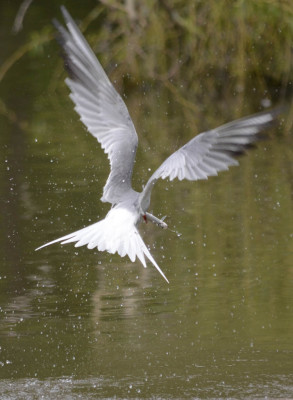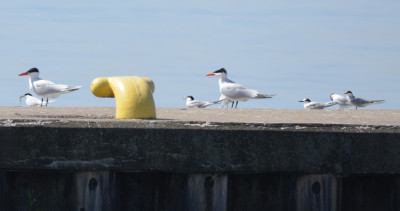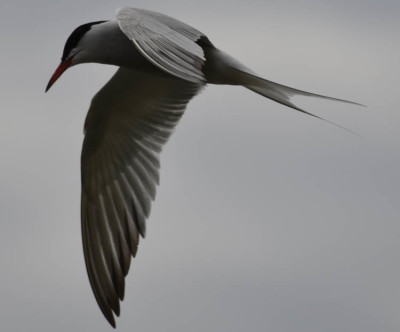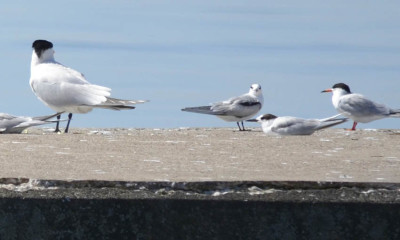On a recent visit to Bronte Harbour in Oakville Ontario, I saw several fishers casting into Lake Ontario. No one using a hook and line seemed to be having much luck. I wondered how they felt watching the other fishers who were having repeated success catching shining silver snacks. These more successful fishers were diving from heights of 2 to 10 metres down into the rippling waves before emerging triumphant with their catch. They were Terns. But which kind or whose Terns?
Forster’s Terns a No Show
One type of tern that occasionally shows up around Lake Ontario is Forster’s Tern. There was no sign of any today, nor was I particularly surprised by that. The last sighting of Forster’s around here reported to ebird.org was in April. By June they’ve gone for a while. (It’s worth looking, though, as a couple were seen in Hamilton in late May.) Forster’s Terns look similar to Common Tern’s but are somewhat larger, have white (not grey) underparts near the front, and often have white primaries, not grey ones.
Caspian’s Terns Were Loafing
Unlike the industrious smaller terns, several Caspian terns were lazing on the breakwater. They dwarf the Common Terns which is particularly noticeable when they perch alongside one another. They sport a thick strong orange-red bill and often a jaunty little crest at the back of their head.
Common Terns Keep Catching Fish
While some of the Common Terns were taking five on the breakwater, most were in the air. Like agile aircraft, they patrolled up and down the Lake and in and out of the harbour. If they spotted a swirl or glimmer, they would bank abruptly, coming around in a tight circle for a closer look.
If a fish looked at the right depth, the Tern would dive swiftly. About every third time, the Tern would win and would flap up from the water with a glittering prize. The other times, the Terns just shook off the annoying droplets and started patrolling again.
But Wait, Those Terns Have Lost Half Their Headgear
While flipping through my photos at home, I realized that some of the Common Terns weren’t sporting their full black ball cap of feathers. Instead, their foreheads were still bright white. They also had a darker bar of feathers across the top of their wing. And their bills were black, not red or orange. These must be immatures. But how young were they?
According to The Sibley Guide to Birds, Common Terns born this year should be rather dusky with brownish bars, not crisp white and grey. In their first full summer of life and their second full year they are grey and white but don’t have the adult’s full black cap.
Did that mean these ones I was watching were “First Summer” or “Second Summer” Terns? National Geographic said that First Summer birds were unusual in North America. But had the birds read the book?
A bit puzzled, I posed the question to the more experienced birders at OutdoorOntario.net. I’m sure some of them have been down at Tommy Thompson Park where the Common Tern colonies nest. With so many recent examples fresh in their minds, they should be able to help me decide how old these terns were.
The verdict was that these were likely first summer birds. So much for the books!
Arctic Terns Sometimes Fly By
It’s also possible to meet an Arctic Tern along the shores of Lake Ontario. The last case reported on ebird.org, however, was in 2010. So I wasn’t surprised to not find any.
Happy Fishing
Hopefully the human fishers eventually caught a few for frying. If not, maybe they should try training some terns. The people in several countries taught Cormorants to fish for them. Come to think of it, we have lots of Cormorants around Lake Ontario, too. So either way, our fishers should consider new approaches if the old string-hook-and-worm technique isn’t working anymore.
Related Reading
Join In
Have you had terns harshly muttering over your head while you walk along the shore? Were any of them suffering from a receding black-feather line on their foreheads? Please share your views with a comment.




